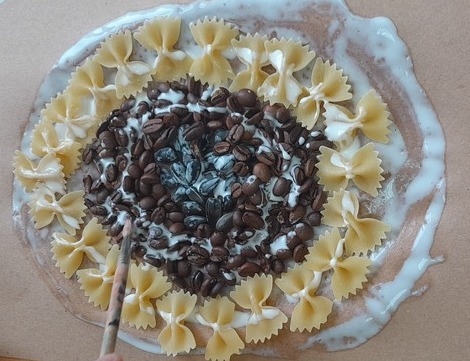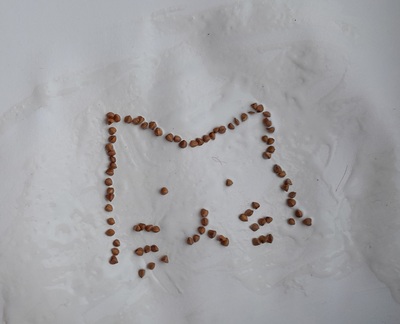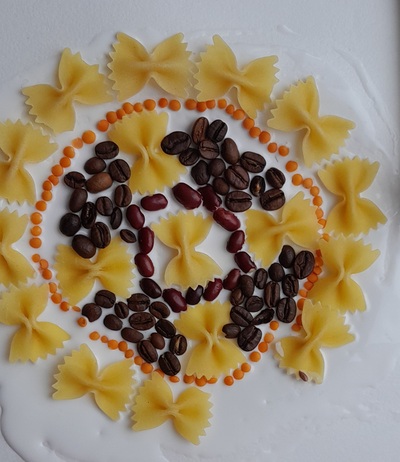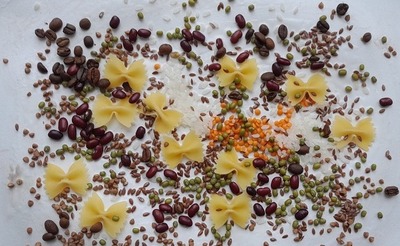
I was looking for the inspration for our final month of Art. I did not start this year with a curriculum for all nine months, although probably, that would have been the recommended and adult course of action. Instead, I spent all these months just getting a theme for September, October, November…
Then came May and I needed something different, something interesting and something that starts with the letter M, just like this month.

The artists
This was an important part of the lesson to give the kids a chance to understand what a mandala is and many different techniques there are to create it. I focused on the simplest and the most basic and straighforward meaning of a mandala representing the Earth.
We looked at three different artists who are famous for their mandalas and the materials they used because I also wanted to have a representation of a variety of tools. That is why we looked at Jamie Locke who carves her mandalas, Damien Hirst who composes his out of butterflies (I still cannot get over the fact that these are real butterflies) and Stephen Meakin who painted his.

The language
Only after we looked at the artists, did we go through the language for the day, namely all of the materials to be used in class and, as usual, we used the wordwall cards. The cards and the vocabulary have been consistent with what I found at home and in my local supermarket and consistent with all the materials that I wanted to use. That is why have here beautifully green mungo beans and orange lentils.
I am aware of the fact that these are not the most commonly used words, especially by beginners but I did not want to extend the langauge slot because making a mandala takes time and we have only 45 minutes at our disposal.

The art
Mandalas are beyond beautiful and, esentially, very easy to make, albeit time-consuming. As regards materials, you only need a lot of PVA kids glue (I tried to use the regular glue stick but it is not that effective), cardboard (as the regular paper will not be able to keep up with the large amount of glue) and the seeds of your choice.

As usual, we prepared the working stations on kids’ separate desks and all of the materials were placed in boxes and in bags on the table at the front of the classroom. I also had a few separated containters (deep lids from plastic boxes). The students were told to come up, choose their material, one at a time, and either take the chosen box to their table or to take some of the material into a separate lid to move them around the room. We put on our aprons and I gave our small paintbrushes in order to move the pieces around to avoid touching the glue, as much as possible. I also gave a long, serious and boring speech in both languages about not eating anything on the table. ‘This is not food, these are materials right now. We don’t eat the materials’ could be the summary.

The actual making of the mandala is super easy and, apart from showing the children the one I made at home, I also started another one in the classroom. There are three easy steps: attaching the paper to the table with painter’s scotch, squeezing out a large blob of glue and smearing it in a circle and starting the mandala from the centre, going out and around. If necessary, another layer of glue might be added as it dries out and another layer might be added at the end of the of the process, especially for the big bits, such as the pasta pieces. The PVA glue dries beautifully and it becomes transparent, without destroying the picture.
We left ours to dry on the window sill and on the following day, I put them up in the polly pockets and kids took them home.
Why we loved it?
- Just like the tiny pictures, this activity does wonders for developing focus and concentration. Everyone stayed focused, everyone stayed silent and they were just working beautifully.
- It is also a lovely task to develop cooperation skills because even though we had a selection of materials and boxes, the kids still had to wait, to share, to negotiate and I am very happy to say it went well.
- The task involves a lot of self-control as, despite the fact that all of these were hard, raw and not very tasty grains, some of my students were still asking for the permission to eat them, just to try. One of the boys even left the room because he knew he wouldn’t be able to resist but then he came back and worked well, only talking about eating our materials. I am trying to say that I was happy that I waited with such a task until the end of the year, when we had already our routines and rules developed and in place. I would not recommend doing it in September or until the group is ready for it.
- The kids loved the work, too and, as you can see in the photos, the majority of them went for a traditional mandala, some decided to create chaos which is also beautifully represented in the world. Some of my Super Artistic Stars went for their signature items such as the rabbit and the goose or the cat which Alex, laboriously, constructed out of the buckwheat pieces. We had a few flowers, too.
- This was one of the rare cases when I did not plan on displaying the art on the wall and all kids took their pieces home. I was worried that on the wall, unsupervised, the pieces might be picked up by some of the students and consumed. I really didn’t want to risk that and we do not have closed cases in our school in which the mandalas could be safely displayed. Plus, of course, everyone wanted to take their creations home, as soon as possible.
- I was thinking of the ESL / EFL classes in which this kind of craft could be used and here are some of the ideas (although I feel obliged to mention that I have not used them in class myself, not in that format): a lesson on the natural world, a space lesson craft, with everyone creating their own planet, a lesson on big numbers in which we could count all the pieces used and, in a Science lesson – on grains and seeds.



Happy teaching!
P.S. A request!
It is very simple.
I would like to know a tiny little bit more about my readers. There are so many of you, popping in here, again and again, and the numbers of visitors and visits are going up and make my heart sweel with joy. But I realised I don’t know anything about my readers and I would love to know, a tiny little bit more.
Hence the survey.